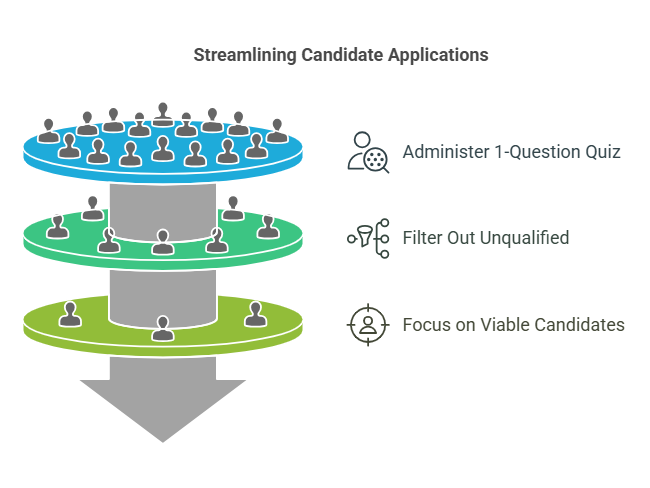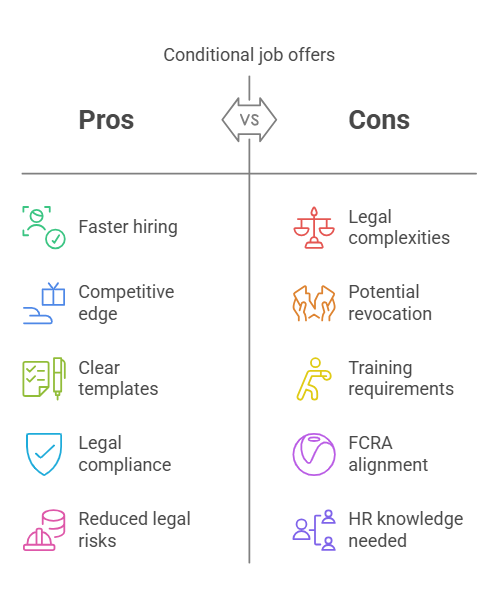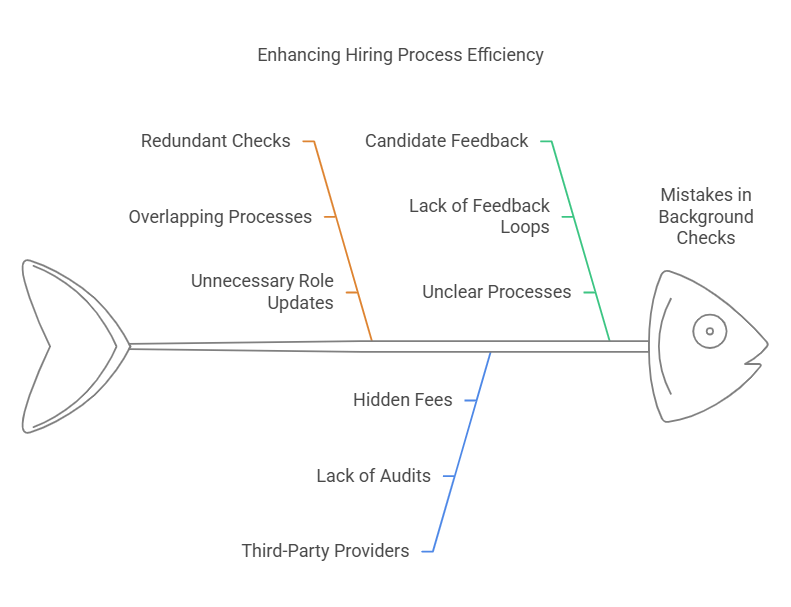Creating an outstanding candidate experience is no longer just a "nice to have" for staffing agencies; it's a necessity. Optimizing the candidate journey in a highly competitive industry can lead to quicker placements and immense reputation boosts. This guide unravels five pivotal hacks aimed at enhancing the candidate experience and expediting the hiring process. Let's dive into the strategies that can minimize drop-offs and accelerate placements.
Key Takeaways
- Improving candidate experience is essential for staffing agencies to maintain their reputation and secure top talent efficiently.
- Background checks should be fast and well-managed to prevent candidate drop-offs and enhance trust in your agency.
- Streamlining the application process and ensuring mobile compatibility can significantly reduce drop-off rates and improve candidate satisfaction.
- Leveraging conditional job offers with proper legal safeguards and transparent communication can expedite the hiring process.
- Designating a Single Point of Contact for candidates during screening can significantly improve satisfaction and engagement.
Introduction
Poor candidate experience costs staffing agencies more than just missed hires; it chips away at their reputation. In a market where speed and credibility count, refining this experience is crucial.
Focusing on the background check process can speed up placements and enhance your agency's standing. Simple changes can cut down candidate drop-offs and fast-track hires.
We'll explore five practical hacks to improve your candidate experience and get results faster. Ready to streamline your process and improve your placements? Let's get started.
Why Candidate Experience Matters in Staffing
Effective candidate experience is crucial in the staffing world. In fact, statistics show that 40% of candidates abandon applications if background checks take more than three days. This delay can cost you top talent and damage your reputation.
Imagine the impact of a positive candidate experience. Satisfied candidates are likely to come back, make referrals, and improve your time-to-fill metrics. They trust the process and, in turn, trust your agency.
Background checks play a pivotal role here. Fast, efficient screenings keep candidates engaged and reduce the risk of drop-offs. Maintaining transparency and keeping the process seamless builds trust.
Ask yourself: how often has a slow screening process cost you a valuable candidate? Reducing the time taken for these checks can make a significant difference in your placement speed.
Consider streamlining your background check process. This simple action can enhance candidate satisfaction and lead to faster placements. How can you improve your process to meet candidate expectations?
In the competitive staffing arena, fine-tuning every aspect of the candidate's journey isn't just strategic—it's essential for success. You have the power to shape experiences that keep candidates coming back. Are you ready to make that shift?
EXPERT INSIGHT: Name a game-changing process by HR -- That's absolutely "candidate experience." Every interaction from the day the applicants submit their resume until the time they have signed the job offer, up to onboarding, matters. As HR professionals, our role is not only to fill the roles but also to make sure that we offer best-in-class recruitment services to candidates. It is a way of building trust and marketing the kind of culture that we have in our organization. This is like building a long-term relationship that can help foster a positive culture and help attain the goals of the company as people are the assets of the company. Charm Paz, CHRP
Hack 1: Streamline Pre-Screening with a 1-Question Eligibility Quiz
Streamlining your application process can significantly impact both recruiters and candidates, cutting down on inefficiencies and boosting satisfaction all around.
One problem many agencies face is the sheer volume of applications. Each position can attract hundreds of candidates, many of whom may not meet even the basic requirements. This clogs the system, making it hard for recruiters to focus on viable candidates and frustrating applicants as they get lost in the shuffle.
A straightforward solution is to implement a 1-question eligibility quiz. This simple step can screen out those who clearly do not meet the required qualifications for a role. For instance, asking, "Do you possess a valid driver’s license for this delivery role?" can instantly filter out candidates who don't meet this basic requirement.

Consider a logistics agency that put this into practice; they reduced unqualified applicants by 60%. That's a significant decrease in workload and an increase in focusing razor-sharp on viable candidates.
Here's how you could set this up: Utilize user-friendly tools like Typeform or Google Forms to create your quiz. Your questions must remain free of discrimination to ensure legal compliance. This keeps the process fair and efficient.
Enhancing your candidate experience with this method connects directly to background checks. Efficient pre-screening means you'll spend less time sifting through mismatched candidates later in the process.
So, ask yourself: Can you afford not to streamline? Is this simple quiz the next step for your agency's efficiency?
Hack 2: Use Mobile-Friendly Consent Forms to Reduce Drop-Offs
Forms that only work on desktops alienate candidates who primarily use their phones. This exclusion can cause substantial drop-offs in your candidate pool.
Design forms to be responsive on mobile devices and use e-signature solutions. These changes make the process easier for candidates on the go.
In one case, a healthcare staffing agency slashed consent form abandonment rates by 45% with mobile optimization.
Here's how to implement this:
- Use mobile form best practices, like succinct fields and auto-fill options.
- Employ tools like DocuSign or HelloSign for compliant digital signatures.
- Ensure adherence to GDPR and FCRA guidelines to safeguard data integrity.
Why do candidates abandon the process due to mobile consent issues? Often, it boils down to cumbersome layouts or lengthy input requirements.
Streamline and simplify. Your focus should be on making the experience seamless.
Hack 3: Offer Instant Conditional Offers (With Legal Safeguards)
Prolonged screening periods can lead top candidates elsewhere. You need speed to secure talent by offering conditional job offers right after the interview.
Consider this: a tech staffing firm cut its time-to-hire by 30% by doing just that. They extended offers that hinged on successful background checks, staying a step ahead of the competition.
Start with clear, precise templates for your conditional offers to replicate this. Make sure your wording includes clauses that you can revoke offers should the background checks raise concerns. This keeps you compliant and reduces potential legal headaches.

It's critical to align your policies with FCRA guidelines to protect both your agency and candidates. Regular training on legal updates can enhance compliance.
Are instant conditional offers secure enough legally? Yes, with the right safeguards. Ensure your HR team knows what can make or break these offers in court.
Hack 4: Share Transparent Screening Timelines
The unknown causes stress. In a hiring process, uncertainty about timelines often pushes candidates to vanish. So how do you fix that? Clearly communicate screening timelines upfront. Tell candidates, "Expect your screening to take 3-5 days." Simple yet powerful.
Templates make this easy. Create email or portal messages that outline the timeline. Consistent communication builds trust.
Delays happen. Be proactive. Use SMS alerts or status dashboards to provide updates. No one likes waiting in the dark. Let technology work for you. Collaborate with providers to track real-time progress. It keeps candidates engaged and informed.
Managing expectations is key. Would you want to know how much longer you have to wait? Keep this thought in mind when planning your communication strategy. It can make a world of difference in candidate retention.
Hack 5: Assign a Single Point of Contact (SPOC)
Managing multiple contacts during the screening process is frustrating for candidates. It leaves them confused and reduces trust. A Single Point of Contact (SPOC) changes the game by providing candidates with a dedicated person for all their screening-related questions.
Consider a finance staffing agency that implemented SPOCs. They saw a 35% boost in candidate satisfaction scores. Why? Because candidates felt guided and their concerns were promptly addressed.
To make this work, train your SPOCs on common screening issues. They should know your process inside out and be ready to help. Equip them with CRM tools like Salesforce or HubSpot for seamless tracking and communication.
Is a dedicated screening support team necessary? Not always. A SPOC can be as effective, providing a personal touch without overwhelming resources.
Explore how a SPOC could improve your agency's candidate experience. It’s a simple fix that could make a significant difference.
Common Pitfalls to Avoid
Background checks are a critical part of the hiring process, but they can be fraught with mistakes. These missteps could slow down placements and tarnish your agency's reputation.

Mistake 1: Subjecting candidates to redundant checks. You don't need to make candidates jump through hoops. If they're updating roles within the same company, reconsider whether new checks are necessary. Review your process to eliminate overlap. By omitting redundant checks, you save time and enhance candidate satisfaction.
Mistake 2: Neglecting to audit third-party screening providers. Your reputation can hinge on these providers. Regularly review their accuracy and speed. Poor performance on their part affects your agency. Check for any hidden fees or compliance shortfalls. Ensuring your partners are effective keeps your process smooth.
Mistake 3: Overlooking candidate feedback loops. Candidates can offer valuable insights into your processes. Are they clear and user-friendly? If you're not gathering feedback, you're missing out on a tool for improvement. Regular feedback loops help you refine and optimize the candidate experience, fostering trust and efficiency.
Avoid these pitfalls to maintain a seamless and effective hiring process. Consider how each one might impact your agency and address them promptly for smoother operations.
Measuring the Impact of Candidate Experience Hacks
Track the effectiveness of your candidate experience adjustments or risk running blind. Key Performance Indicators (KPIs) are your roadmap.
Start with drop-off rates. Examine each stage of the recruitment process. Identify where most candidates exit. When using a new mobile consent form, did you notice fewer drop-offs? That's progress.
Look at time-to-fill. A faster process means fewer job seekers are lost to competitors. Implement instant conditional offers and check if the average time to fill roles decreases. Even a slight reduction matters.
Use candidate satisfaction surveys. Ask them directly about their experience. A Net Promoter Score (NPS) is simple and revealing. Are candidates likely to refer others? Their answers can illuminate surprising insights.
Select the right tools for precise measurements. Google Analytics can help you track where candidates abandon forms, while ATS dashboards provide a broader overview of the recruitment process.
Regularly review this data. Small tweaks based on these insights can have significant impacts over time. Remember, optimizing experience is a continual process, not a one-time event.
Conclusion
Each hack plays a significant role in streamlining your recruitment process and building stronger relationships with clients. They improve how candidates perceive your agency and can drastically reduce hiring times.
To see results, try implementing one hack at a time. Start with something simple, like mobile-friendly forms. This step alone can lead to noticeable changes in candidate engagement.
Remember, improving the candidate experience isn't just about being kind or courteous. It's a strategic move that gives you an edge in a competitive market.
Frequently Asked Questions
How to make a good candidate experience?
To create a positive experience, focus on clear communication and prompt feedback. Personalize interactions to show that you value each candidate. Streamline application processes and ensure interviews are informative and respectful. Offer transparency about timelines and decisions. Example: Send a detailed interview agenda to help the candidate prepare.
How to calculate candidate experience?
Gather feedback through surveys at various stages of the hiring process. Track metrics like candidate satisfaction scores, time to hire, and conversion rates. This data highlights areas for improvement. Engage with candidates post-process to assess their overall experience.
How do you describe your recruiting experience?
Recruiting experience involves sourcing, evaluating, and hiring candidates. It requires skills in communication, relationship-building, and decision-making. Recruiters guide candidates through the hiring process while representing the organization's values and culture.
What is a candidate experience survey?
A candidate experience survey is a tool to gather feedback from candidates about their application and interview experience. It includes questions about communication, process clarity, and overall satisfaction. Insights from surveys help improve future recruiting efforts.
What are the common components of a good candidate experience?
Prompt communication, personalized interactions, efficient interview processes, and timely feedback are key. Enhancing these elements ensures candidates feel valued and respected.
Why is candidate experience important?
A positive experience leaves candidates with a strong impression of your organization, impacting your employer brand. It can lead to recommendations, reapplications, or even future business relationships.
How can technology enhance candidate experience?
Utilize tools like applicant tracking systems and automated communication software to streamline processes. These help manage applications efficiently, keeping candidates informed and engaged without adding administrative burden.
What role does company culture play in candidate experience?
Company culture should be communicated clearly throughout the recruitment process. Aligning the process with your culture helps candidates assess if they’ll fit in, making for a more genuine connection from the start.
Definitions
Understanding the industry terms is the key to navigating the recruitment process with ease. Here is a compilation of terms for you. Take note that familiarizing yourself with these will help you streamline processes, build trust with candidates, and make informed hiring decisions. Let’s break them down.
- Candidate Experience - The overall impression a job seeker has of a staffing agency throughout the hiring process. It includes everything from initial application to communication, interviews, background checks, and final decisions. A smooth experience increases trust and reduces drop-offs.
- Background Check - A screening process used by staffing agencies to verify a candidate’s qualifications, work history, criminal record, or other relevant information. Quick and transparent background checks help speed up hiring and improve candidate engagement.
- Time-to-Fill - The number of days it takes to hire a candidate from a job posting to accept an offer. Reducing this timeframe helps agencies secure top talent before they accept offers elsewhere.
- Conditional Offer - A job offer that depends on the candidate passing certain requirements, such as background checks or additional screenings. Clearly written conditions protect both the agency and the candidate from misunderstandings.
- Single Point of Contact (SPOC) - A dedicated individual who handles all candidate interactions during the hiring process. Having one contact person reduces confusion, improves communication, and enhances overall satisfaction.
Still have questions?
Get in touch with our team today for a personalized demo and discover how our tailored volume pricing and packages can drive results for your business!
How useful was this page?*
Note: your comments are anonymous. We use them to improve the website. Do not include any personal details.
Visit our FCRA Compliance Tool or leave a message here if you need a response.
From the blog Explore the GCheck Content Hub

Prescription Drugs That Show Up on Drug Tests: A Compliance Guide
4 Dec, 2025 • 18 min read
Seasonal Employee Background Checks: Protecting Your Business During Peak Hiring Periods
4 Dec, 2025 • 22 min read
Background Check for Volunteers vs Employees: Legal Frameworks and Screening Protocol Development
3 Dec, 2025 • 14 min readThe information provided in this article is for general informational and educational purposes only and should not be construed as legal advice or a substitute for consultation with qualified legal counsel. While we strive to ensure accuracy, employment screening laws and regulations—including but not limited to the Fair Credit Reporting Act (FCRA), Equal Employment Opportunity Commission (EEOC) guidelines, state and local ban-the-box laws, industry-specific requirements, and other applicable federal, state, and local statutes—are subject to frequent changes, varying interpretations, and jurisdiction-specific applications that may affect their implementation in your organization. Employers and screening decision-makers are solely responsible for ensuring their background check policies, procedures, and practices comply with all applicable laws and regulations relevant to their specific industry, location, and circumstances. We strongly recommend consulting with qualified employment law attorneys and compliance professionals before making hiring, tenant screening, or other decisions based on background check information.


